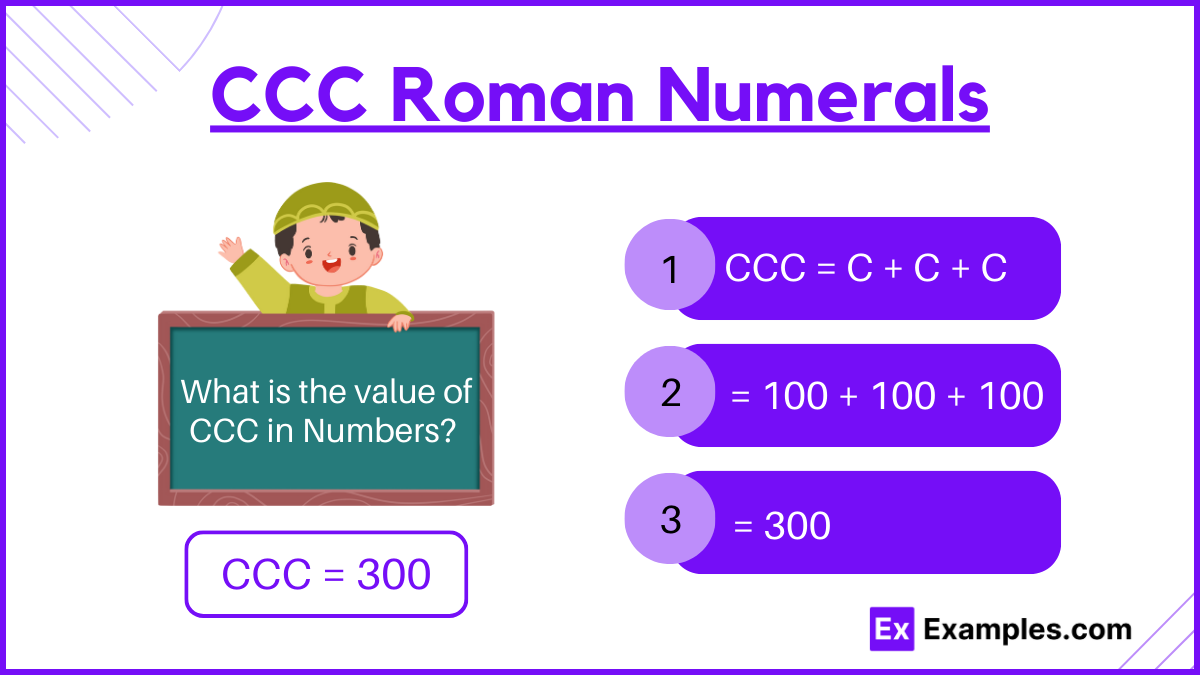What is the value of CCC in Roman numerals?
100
200
300
400


Roman numerals have a rich history and remain relevant today. The numeral CCC represents 300, with each ‘C’ standing for 100. Repeating ‘C’ three times equals 100 + 100 + 100. Understanding such conversions is essential for interpreting historical documents, clocks, and more. This article explains how to correctly translate CCC to 300, ensuring clear comprehension of this ancient numbering system.
CCC = 300
Converting Roman numerals like CCC to numbers can be achieved using different approaches. Here are two effective methods to determine the value of CCC Roman numerals:
The Direct Addition Method involves adding the values of each ‘C’ in CCC, where each ‘C’ equals 100:
CCC = C + C + C = 100 + 100 + 100 = 300
The Multiplication Method involves identifying ‘C’ as 100, then multiplying by its three occurrences in CCC:
100×3=300. Thus, CCC translates to 300.
Roman numerals, used in ancient Rome, employ combinations of the Latin letters I, V, X, L, C, D, and M. Though they may look different from modern numbers, they function similarly. For instance, the Roman numeral CCC equals 300. Here are some related Roman numerals and their numeric equivalents:
Problem 1: What is the sum of CCC and L in Roman numerals?
In Roman numerals, 350 is written as CCCL.
Problem 2: What is the result when you subtract XXX from CCC in Roman numerals?
In Roman numerals, 270 is written as CCLXX.
Problem 3: Convert the Roman numeral CCCXLV to a number.
Thus, CCCXLV equals 345.
Problem 4: What is the sum of CC and CCI in Roman numerals?
In Roman numerals, 401 is written as CCCI.
Problem 5: Convert the number 358 to Roman numerals.
Thus, the number 358 is written as CCCLVIII in Roman numerals.
CCC XL in Roman numerals equals 340. CCC is 300, and XL is 40, so together they add up to 340.
The Arabic number for CCC in Roman numerals is 300. Each ‘C’ represents 100, so CCC equals 100 + 100 + 100.
CCC XXVI in Roman numerals equals 326. CCC is 300, and XXVI is 26, so together they add up to 326.
CCCC is not a standard Roman numeral. Instead, 400 is written as CD, combining 500 (D) minus 100 (C).
Text prompt
Add Tone
10 Examples of Public speaking
20 Examples of Gas lighting
What is the value of CCC in Roman numerals?
100
200
300
400
Which Roman numeral equals 300?
CC
CCC
CD
CCI
Convert the Roman numeral CCC to its Arabic numeral equivalent.
200
250
300
350
If CCC is subtracted from M (1000 in Roman numerals), what is the result?
DCC
MCC
CCL
DCCL
What is the sum of CCC and LXXX in Roman numerals?
CCCLXXX
CCCL
CCL
CCCC
What is the Roman numeral representation for 300?
CXX
CCCC
CCC
CC
Which numeral represents 300 in Roman numerals?
CCC
CCL
CC
CL
What is the difference between CCC and CCL in Roman numerals?
C
CC
L
D
What is CCC plus XXI in Roman numerals?
CCCXXI
CCCX
CCCL
CCCXL
What Roman numeral represents the value 300 subtracted from 400?
C
CC
CCC
CD
Before you leave, take our quick quiz to enhance your learning!

